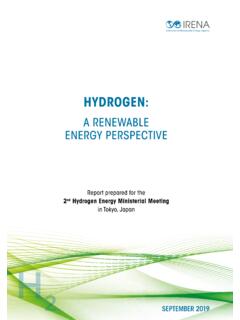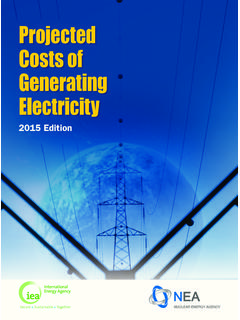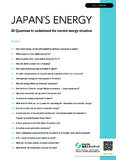Transcription of Tidal Energy Technology Brief - irena.org
1 IRENA. International Renewable Energy Agency Tidal . Energy . Technology Brief . IRENA Ocean Energy Technology Brief 3. June 2014. Copyright (c) IRENA 2014. Unless otherwise indicated, material in this publication may be used freely, shared or reprinted, so long as IRENA is acknowledged as the source. ABOUT IRENA. The International Renewable Energy Agency (IRENA) is an intergovernmental organisation that supports countries in their transition to a sustainable Energy future, and serves as the principal platform for international co-operation, a centre of excellence, and a repository of policy, Technology , resource and financial knowledge on renewable Energy .
2 IRENA. promotes the widespread adoption and sustainable use of all forms of renewable Energy , including bioenergy, geothermal, hydropower, ocean, solar and wind Energy , in the pursuit of sustainable development, Energy access, Energy security and low-carbon economic growth and prosperity. ACKNOWLEDGEMENTS. The Brief has benefited from the participants of two review meetings on 21 January 2014. in Abu Dhabi, and 11 April 2014 in Brussels. Furthermore, very valuable feedback and comments have been received from France Energies Marine, Jared Goldsmitt (DNV GL), Vincent de Laleu (EDF Energy ), Davide Magagna (EC), Alice Monnet (GDF Suez), Dee Nunn (RenewableUK), Sandra Parthie (Alstom), Matthijs Soede (EC), Luis Villate (Technalia), Jochen Weilepp (Hochschule Biberach), Miles Willis (Swansea University), and Ana Novak Zdravkovic (Laborelec, GDF Suez).
3 Authors: Ruud Kempener (IRENA), Frank Neumann (IMIEU). For further information or to provide feedback, please contact: Ruud Kempener, IRENA. Innovation and Technology Centre. E-mail: or Disclaimer While this publication promotes the adoption and use of renewable Energy , the International Renewable Energy Agency does not endorse any particular project, product or service provider. The designations employed and the presentation of materials herein do not imply the expression of any opinion whatsoever on the part of the International Renewable Energy Agency concerning the legal status of any country, territory, city or area or of its authorities, or concerning the delimitation of its frontiers or boundaries.
4 Highlights Process and Technology Status There are three categories of Tidal Energy technologies. The first category, Tidal range technologies use a barrage a dam or other barrier to harvest power from the height dif- ference between high and low tide. The power is generated through Tidal turbines (most of them come from hydropower design, such as bulb turbines) located in the barrage, and their commercial feasibility has been well established through the operation of plants in France (240 Megawatts (MW)), Canada (20 MW), China (~5 MW) and Russia ( MW) from the 1960s and 1970s. In 2011/2012, South Korea opened the largest and newest Tidal barrage (254 MW).
5 New technologies developed for Tidal range power generation are Tidal lagoons', Tidal reefs', and Tidal fences', and low-head Tidal barrages. The second category, Tidal current or Tidal stream technologies have had more than 40 new devices introduced between the period 2006-2013. The major differences among the devices are the turbines, which can be based on a vertical or horizontal axis, and in some cases are enclosed (ducted). Full-scale deployment of single turbines have been achieved, and the next step is the demonstration of arrays of turbines ( Energy Technologies Institute (ETI)/ UK Energy Research Centre (UKERC), 2014).
6 Up to 2010, the industry was dominated by small entrepreneurial companies, but in the last three years large engineering firms and turbine manufacturers like ABB, Alstom, Andritz Hydro, DCNS, Hyundai Heavy Industries, Kawasaki Heavy Industries, Siemens, and Voith Hydro have entered the market. Fur- thermore, companies like General Electric (GE) have also shown an interest and are supplying the electrical power systems for some of the prototypes. Also, large utilities like Bord G is Energy , lectricit de France (EDF), GDF. Suez, and Iberdrola are running demonstration projects. Some Tidal current or Tidal stream technologies are also used to harvest ocean currents.
7 Compared to Tidal currents, ocean currents are unidirectional and generally slower but more continuous. Ocean current technologies are in an early developmental stage, and no full-scale prototype has been tested or demonstrated yet. The final category, hybrid applications are forms of Tidal range technologies that have great potential if their design and deployment can be combined T idal E nergy | Technology B rief 3. with the planning and design of new infrastructure for coastal zones. Project proposals for hybrid applications exist in Canada (British Columbia), China, the Netherlands (Grevelingen), Norway (E39 road project) and the UK (Bristol Channel).
8 Furthermore, there are plans for a hybrid form of Tidal range and current power generation called dynamic Tidal power '. Again, no full-scale prototype has been tested or demonstrated yet. Potential Worldwide, the technically harvestable Tidal Energy resource from those areas close to the coast, is estimated by several sources at 1 terawatts (TW). The potential for Tidal current technologies is larger than for Tidal range. Total Tidal range deployment in 2012 was around 514 MW, and around 6 MW for Tidal current (of which 5 MW is deployed in the UK). Extensive plans exist for Tidal barrage projects in India, Korea, the Philip- pines and Russia adding up to around 115 gigawatts (GW).
9 Deployment projections for Tidal current up to 2020 are in the range of 200 MW. An advantage of both Tidal range and Tidal current Energy is that they are relatively predictable with daily, bi-weekly, biannual and even annual cycles over a longer time span of a number of years. Energy can be gener- ated both day and night. Furthermore, Tidal range is hardly influenced by weather conditions. Cost indications Tidal range power generation is dominated by two large plants in operation, the La Rance' barrage in France and the Sihwa dam' in South Korea. The construction costs for La Rance' were around USD 340 per kilowatt (/kW) (2012 value; commissioned in 1966), whilst the Sihwa barrage was constructed for USD 117/kW in 2011.
10 The latter used an existing dam for the construction of the power generation Technology . The construction cost estimates for proposed Tidal barrages range between USD 150/kW in Asia to around USD 800/kW in the UK, but are very site specific. Electricity production costs for La Rance' and Sihwa Dam'. are EUR per kilowatt-hour (/kWh) and EUR , however these costs are very site specific. Tidal range technologies can be used for coastal projection or water management, which would reduce the upfront costs. On the other hand, additional operational costs may occur due to the control, monitoring and management of the ecological status within the impoundment.












